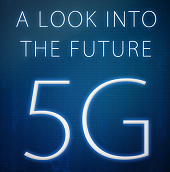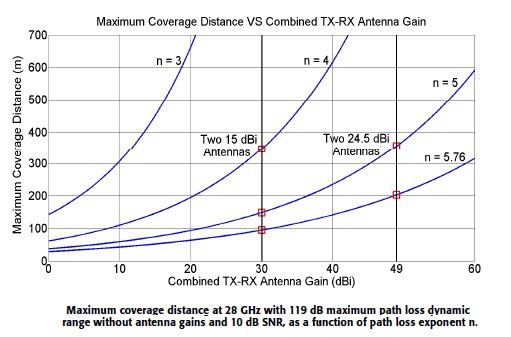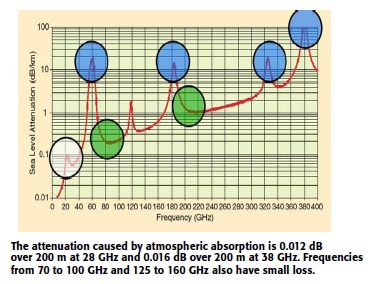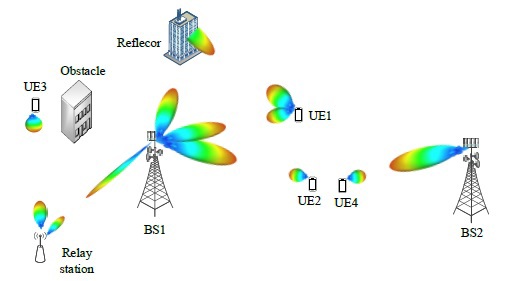5G radio interface
Considered one of the most important features of promising networks of the 5th generation: the use of the millimeter frequency range.
The article is based on the personal experience of the author in studying the appearance of future 5G networks in one of the leading European universities and communicating with people directly involved in this field. In view of the meager number of technical publications on the 5G radio interface in Russian (which is very sad), the author hopes that the article will be useful to all who are interested.

5th generation (5G) wireless technologies are expected to start entering our lives in 2020. They will have to bring the quality of the services provided to a whole new level, all in the context of the exponential growth of traffic in mobile networks and the increasing number of devices connected to such networks.
')
It is important to note that 5G developers are thinking about the long run, about ensuring that 5G in the future is so flexible and “powerful” that they can create an infrastructure for such applications that we are just starting to think about today. For example, research is being conducted on how 5G will become an important component for the infrastructure of unmanned vehicles in the future.
At the level of the concept developed in the framework of the European project METIS [1], three basic basic services are assumed (generic 5G services) provided by 5G networks and differing in different requirements for network parameters:
The last two are particularly important in the context of the now fashionable concept of the Internet of Things.
By the way, at the beginning of July the second phase of the project, METIS-II, was launched, the results of which will determine the more or less final appearance of the 5G radio access network.

In general, the very possibility of such highly advanced infrastructure services should be based on four key principles [1]:
Currently, among the developers and researchers, there is a consensus that future 5G networks will go (however only partially) to the microwave frequency bands (3-30 GHz, 10-1 cm) and possibly even EHF (30-300 GHz, 10-1 mm ), [2]. The use of such exotic for mobile radio frequency bands requires a revision of the principles of radio access at both the physical and MAC levels.
For a general understanding of the situation in this range, below are graphs published in [3]. The first graph shows that under various conditions, the communication range at a frequency of, say, 28 GHz, is measured in hundreds of meters, although with the use of antenna systems with high gain and with direct line of sight, the range can increase significantly (according to some sources, up to 1-2 km Microwave range).

On top of that, millimeter waves (mmWaves) are characterized by noticeable attenuation in the atmosphere, as shown in the following graph. What can we say about the attenuation in the obstacles.

Thus, reliable communication in the millimeter range requires the use of highly focused beams under the condition of direct visibility. Or, at a minimum, the use of rays reflected from objects in the immediate vicinity of the transmitter proximity. Fig. from [4]:

Obviously, this in turn entails the widespread use of “ultra-dense” architectural solutions (ultra-dense network solutions): femto and pico-cells (to reduce the required range), together with very directional antennas at both the transmitter and the receiver, if the latter is possible ( to increase the achievable range and even overlap the requirements for this parameter in small cells).
In such a scenario, “full-directional radio communication” (fully-directional communication) is also supported by new MAC layer protocols (as when working on line of sight and on a narrow radio path, the access protocols to the medium change, but this is a topic for a separate conversation) the concept of a noise-limited network architecture (noise-limited network architecture) instead of the architecture adopted today, limited by interference (interference-limited), and subscriber-oriented design (user-centric design) instead of the current design focused on a cell (or vector) (cell-centric design). [four]. Finally, due to the high directivity and dynamic nature of future 5G networks, the concept of “cell” itself will also be revised (this will be discussed below).
Due to short wavelengths in the millimeter range, smaller antenna systems can be used in 5G systems. In particular, special interest and efforts today are chained to the technology of multi-element MIMO antennas (Massive-MIMO). The use of such antenna technologies allows to effectively solve the problems of full-directional radio communication and interference. On the other hand, the need to work in such high ranges causes an increase in the cost and complexity of specific circuit solutions. In fig. the first prototype of a multi-element MIMO system with more than 100 elements (apparently, simple patch antennas) is shown (taken from here www.designworldonline.com/a-new-way-to-accelerate-5g-research ):

However, full-directional radio communication has two significant limitations:
The classical understanding of a cell or sector, based on the criterion of the minimum distance and acceptance of the condition of uniform distribution of the probability of the position of subscribers in the coverage area, becomes practically useless in view of the following fundamental factors:
5G networks will provide a greater number of degrees of freedom in the sense of access to resources, which means that cell / sector parameters and, in particular, their boundaries will be determined as a result of dynamic optimization algorithms for maximizing / minimizing some objective function. In accordance with the requirements for quality of service, such a target system function can be determined by the following network parameters (or their combination): latency, reliability, power consumption, data transfer speed, uniform service quality of customer service, etc.

Moreover, it is assumed that the decision on which system function should be optimized will be made on the basis of what service the subscriber is currently using. Thus, the network configuration that meets the requirements of a service may be performed not by the service provider, but directly by the service provider via the API within the framework of the Software Defined Wireless Networking (SDWN) concept.
Apparently, the optimal approach is that in which 5G networks will adaptively use the advantages of both the “new” and “old” bands. This corresponds to another principle of 5G - heterogeneity . On the other hand, such an approach will ensure interfacing with already existing wireless access systems.
[1] METIS Deliverable D 8.4, “METIS final project report”, 30 April 2015.
[2] METIS Deliverable D 2.4, “Proposed solutions for new radio access”, 28 February 2015.
[3] TS Rappaport et al., “Millimeter Wave Mobile Communications for 5G Cellular: It Will Work!”, IEEE Access, vol. 1, May 2013, pp. 335–49.
[4] H. Shokri-Ghadikolaei, C. Fischione et al., “Millimeter Wave Cellular Networks: A MAC Layer Perspective” Submitted in March 3.
The article is based on the personal experience of the author in studying the appearance of future 5G networks in one of the leading European universities and communicating with people directly involved in this field. In view of the meager number of technical publications on the 5G radio interface in Russian (which is very sad), the author hopes that the article will be useful to all who are interested.

5th generation (5G) wireless technologies are expected to start entering our lives in 2020. They will have to bring the quality of the services provided to a whole new level, all in the context of the exponential growth of traffic in mobile networks and the increasing number of devices connected to such networks.
')
It is important to note that 5G developers are thinking about the long run, about ensuring that 5G in the future is so flexible and “powerful” that they can create an infrastructure for such applications that we are just starting to think about today. For example, research is being conducted on how 5G will become an important component for the infrastructure of unmanned vehicles in the future.
At the level of the concept developed in the framework of the European project METIS [1], three basic basic services are assumed (generic 5G services) provided by 5G networks and differing in different requirements for network parameters:
- Ultra-wideband mobile communications (Extreme Mobile Broadband - xMBB);
- Mass Machine-to-Machine Communication (Massive Machine-Type Communications - mMTC);
- Ultra-reliable machine-to-machine communication (Ultra-reliable MTC - uMTC).
The last two are particularly important in the context of the now fashionable concept of the Internet of Things.
By the way, at the beginning of July the second phase of the project, METIS-II, was launched, the results of which will determine the more or less final appearance of the 5G radio access network.

In general, the very possibility of such highly advanced infrastructure services should be based on four key principles [1]:
- An “economical” approach to network management to reduce signaling traffic and associated overhead costs;
- Flexible network connection when devices perform not only terminal but also infrastructure functions;
- Content localization to reduce load, delay, and traffic aggregation;
- The introduction of new approaches to the use of frequency resource.
1. The transition to the millimeter range - full communication
Currently, among the developers and researchers, there is a consensus that future 5G networks will go (however only partially) to the microwave frequency bands (3-30 GHz, 10-1 cm) and possibly even EHF (30-300 GHz, 10-1 mm ), [2]. The use of such exotic for mobile radio frequency bands requires a revision of the principles of radio access at both the physical and MAC levels.
For a general understanding of the situation in this range, below are graphs published in [3]. The first graph shows that under various conditions, the communication range at a frequency of, say, 28 GHz, is measured in hundreds of meters, although with the use of antenna systems with high gain and with direct line of sight, the range can increase significantly (according to some sources, up to 1-2 km Microwave range).

On top of that, millimeter waves (mmWaves) are characterized by noticeable attenuation in the atmosphere, as shown in the following graph. What can we say about the attenuation in the obstacles.

Thus, reliable communication in the millimeter range requires the use of highly focused beams under the condition of direct visibility. Or, at a minimum, the use of rays reflected from objects in the immediate vicinity of the transmitter proximity. Fig. from [4]:

Obviously, this in turn entails the widespread use of “ultra-dense” architectural solutions (ultra-dense network solutions): femto and pico-cells (to reduce the required range), together with very directional antennas at both the transmitter and the receiver, if the latter is possible ( to increase the achievable range and even overlap the requirements for this parameter in small cells).
In such a scenario, “full-directional radio communication” (fully-directional communication) is also supported by new MAC layer protocols (as when working on line of sight and on a narrow radio path, the access protocols to the medium change, but this is a topic for a separate conversation) the concept of a noise-limited network architecture (noise-limited network architecture) instead of the architecture adopted today, limited by interference (interference-limited), and subscriber-oriented design (user-centric design) instead of the current design focused on a cell (or vector) (cell-centric design). [four]. Finally, due to the high directivity and dynamic nature of future 5G networks, the concept of “cell” itself will also be revised (this will be discussed below).
2. Multiple MIMO — Another Key Technology
Due to short wavelengths in the millimeter range, smaller antenna systems can be used in 5G systems. In particular, special interest and efforts today are chained to the technology of multi-element MIMO antennas (Massive-MIMO). The use of such antenna technologies allows to effectively solve the problems of full-directional radio communication and interference. On the other hand, the need to work in such high ranges causes an increase in the cost and complexity of specific circuit solutions. In fig. the first prototype of a multi-element MIMO system with more than 100 elements (apparently, simple patch antennas) is shown (taken from here www.designworldonline.com/a-new-way-to-accelerate-5g-research ):

3. Problems of full-directional mobile communication and their possible solutions.
However, full-directional radio communication has two significant limitations:
- Blockage of the channel of direct visibility (Blockage) due to all sorts of obstacles on the track. To overcome this unpleasant situation, alternative ways of transmitting the signal must be found, both using beamforming techniques in antenna systems (beamforming techniques) for working on the reflected beam, and using new approaches to the handover and tracking of the subscriber who is in motion. For example, a network may exchange data with a mobile station (MS) via several base stations (BS) at the same time.
- Deafness. The narrow main lobes of the NAM antennas on the MS and BS should be directed exactly at each other, otherwise they simply "will not hear" each other. The solution to this problem is more difficult. requires new approaches for connection establishment procedures. For example, in modern networks, the formation of a narrow beam of radiation pattern occurs only after synchronization using an omnidirectional control channel in the VHF band. However, in 5G networks, such a strategy will lead to problems due to different communication ranges and (more importantly) different signal propagation conditions in two different UHF and microwave bands.
4. Revision of planning principles
The classical understanding of a cell or sector, based on the criterion of the minimum distance and acceptance of the condition of uniform distribution of the probability of the position of subscribers in the coverage area, becomes practically useless in view of the following fundamental factors:
- Consolidation of infrastructure, especially in urban environments;
- High radio directivity;
- Heterogeneity in radio networks.
5G networks will provide a greater number of degrees of freedom in the sense of access to resources, which means that cell / sector parameters and, in particular, their boundaries will be determined as a result of dynamic optimization algorithms for maximizing / minimizing some objective function. In accordance with the requirements for quality of service, such a target system function can be determined by the following network parameters (or their combination): latency, reliability, power consumption, data transfer speed, uniform service quality of customer service, etc.

Moreover, it is assumed that the decision on which system function should be optimized will be made on the basis of what service the subscriber is currently using. Thus, the network configuration that meets the requirements of a service may be performed not by the service provider, but directly by the service provider via the API within the framework of the Software Defined Wireless Networking (SDWN) concept.
5. Conclusion
Apparently, the optimal approach is that in which 5G networks will adaptively use the advantages of both the “new” and “old” bands. This corresponds to another principle of 5G - heterogeneity . On the other hand, such an approach will ensure interfacing with already existing wireless access systems.
Links
[1] METIS Deliverable D 8.4, “METIS final project report”, 30 April 2015.
[2] METIS Deliverable D 2.4, “Proposed solutions for new radio access”, 28 February 2015.
[3] TS Rappaport et al., “Millimeter Wave Mobile Communications for 5G Cellular: It Will Work!”, IEEE Access, vol. 1, May 2013, pp. 335–49.
[4] H. Shokri-Ghadikolaei, C. Fischione et al., “Millimeter Wave Cellular Networks: A MAC Layer Perspective” Submitted in March 3.
Source: https://habr.com/ru/post/263865/
All Articles